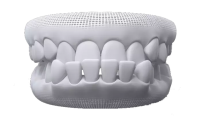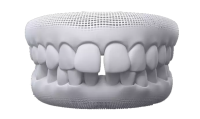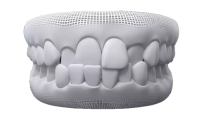Orthodontics is the specialty of dental medicine that aims to prevent and correct malpositions of the teeth and jaws. Orthodontics uses dental braces to align the teeth and improve jaw articulation. This corrects malpositioned teeth and jaw bite. It also improves occlusion, chewing, oral hygiene and oral aesthetics. Orthodontic treatment improves smiles by aligning teeth, improving oral hygiene, reducing the risk of tooth decay and gum problems, restoring chewing and muscle function and restoring jaw joints. The main causes of orthodontic problems can be: hereditary/familial (such as having a relative with a protruding chin or teeth); and/or environmental (such as mouth breathing or thumb sucking). Some of the most common orthodontic problems are: Preventive orthodontics avoids occlusion problems and the need for braces, extraction of permanent teeth and surgery. This type of orthodontics is especially recommended in childhood. Interceptive orthodontics is used when a change is detected that affects the functionality and aesthetics of the mouth. These problems usually occur during the first or mixed dentition. The most commonly used treatment is simple braces (fixed or removable). Corrective or traditional orthodontics is the most widely used and is designed to treat problems with the permanent dentition, such as problems with occlusion and tooth positioning. To do this, mobile or fixed dental appliances are used. It occurs when the upper or lower teeth are protruded in relation to the jaw. This complication can make chewing difficult, as well as altering the aesthetics of the smile. It happens when the upper teeth mostly cover the lower teeth. This can lead to occlusal trauma and wear on the incisor teeth of the lower arch. It occurs when the teeth of the upper jaw do not contact those of the lower jaw, i.e. there is a malocclusion. Grinding your teeth and the consequences of this action can be corrected with orthodontic treatment, especially when the root of the problem is malocclusion or crooked teeth. This refers to excessive space between teeth. This problem can be treated with braces, veneers or a cosmetic restoration. It happens when the teeth of the upper jaw fit inside those of the lower jaw. This is an orthodontic treatment that must precede the placement of implants or crowns. Nowadays, there are different types of fixed and removable dental braces, which allow you to move your teeth and jaws as required. Here are some examples: There are many types of fixed dental braces, which can be divided into metal and aesthetic. These are invisible dental braces, with thin, transparent aligners that fit onto the tooth, applying some pressure so that the tooth moves into the desired position. This type of orthodontics uses prototyped brackets, made to measure for each patient’s tooth, which are placed on the inside of the teeth. Orthodontic treatments are divided into the following phases: Fixed dental braces contribute to the accumulation of plaque. For this reason, it is essential that people who wear braces brush their teeth after every meal with an orthodontic brush and fluoride paste and follow the next steps: We reply within a maximum of 24 working hours. Orthodontics
What are the advantages of orthodontic treatment?
What are the main causes of orthodontic problems?
What are the most common orthodontic problems?
What types of orthodontics?

Preventive

Interceptive

Corrective
What are some of the most common orthodontic problems?

Projected teeth

Overeating

Open bite

Bruxism

Diastema

Crossbite
Pre-rehabilitation
See our Clinical Cases
What types of braces are there?

Fixed Orthodontics

Invisible Orthodontics

Lingual orthodontics
What are the steps involved in orthodontic treatment?
What oral hygiene care should be taken with fixed dental braces?
Frequently Asked Questions
Orthodontics team
BOOK YOUR APPOINTMENT ONLINE
Contact us




















